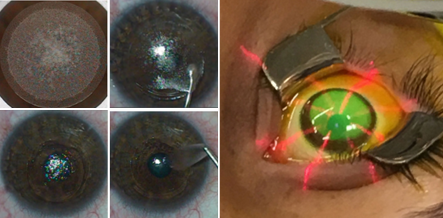 |
There isn’t sufficient evidence to support that performing CXL post-SMILE offers any additional benefit for most patients. Photo: Bobby Saenz, OD (SMILE); Glaukos (CXL). Click image to enlarge. |
The SMILE refractive surgery procedure has lately risen in stature as a more cornea-sparing alternative to LASIK. Would adding a collagen crosslinking (CXL) treatment after SMILE strengthen the cornea even more? Not really, says a recent study.
Researchers recently decided to compare the long-term safety, efficacy, predictability and refractive stability following SMILE vs. SMILE combined with accelerated crosslinking (SMILE Xtra), as well as to specifically study the regression patterns following the two procedures.
A total of 54 eyes of SMILE and 54 eyes of SMILE Xtra patients treated for normal and borderline cases of myopia/myopic astigmatism were included. Both groups were matched for age and refractive error.
The authors did not observe a significant difference in the mean regression between the two procedures at almost the same post-op mean follow-up period of 21 months. Even though the same nomogram (10% over-correction) was applied to both groups, the mean regression in the SMILE XTRA group was slightly higher compared with the SMILE group (0.13D vs 0.08D).
“This may suggest that the UV protocol used in the study may be just sufficient to prevent ectasia,” the authors explained. “The cylinder in the SMILE Xtra group at the mean follow-up was higher compared with the SMILE group (although non-statistically significant), which may suggest that probably we need a longer follow-up to observe these eyes, which may potentially result in ectasia since they all were borderline eyes to start with. On the other hand, this result may also be interpreted that possibly, it is the accelerated crosslinking which is just holding an ectasia, which may otherwise have become evident by now.”
They added that the good stability and minimal regression in the SMILE group at the long-term may suggest SMILE itself is a stable procedure in a majority of cases and SMILE Xtra should only be reserved for cases where the risk of ectasia is higher.
No eye in either group encountered postoperative ectasia; however, some were borderline and “at-risk” for the adverse effect. The authors noted this called for longer and closer follow-ups, “as the prophylactic crosslinking may just be delaying the onset of ectasia, which may occur over a subsequent course of time.”
Brar S, Sriganesh S, Sute SS, Ganesh S. Comparison of long-term outcomes and refractive stability following SMILE versus SMILE combined with accelerated cross-linking (SMILE XTRA). J Ophthalmol. February 28, 2022. [Epub ahead of print]. |


